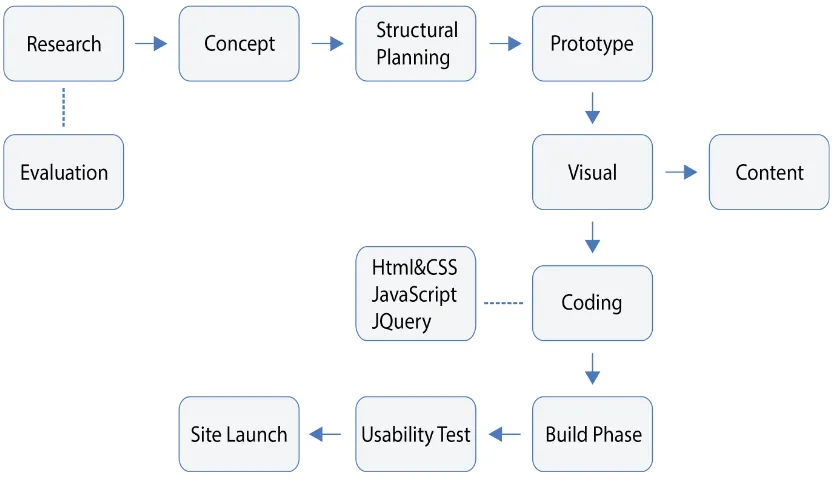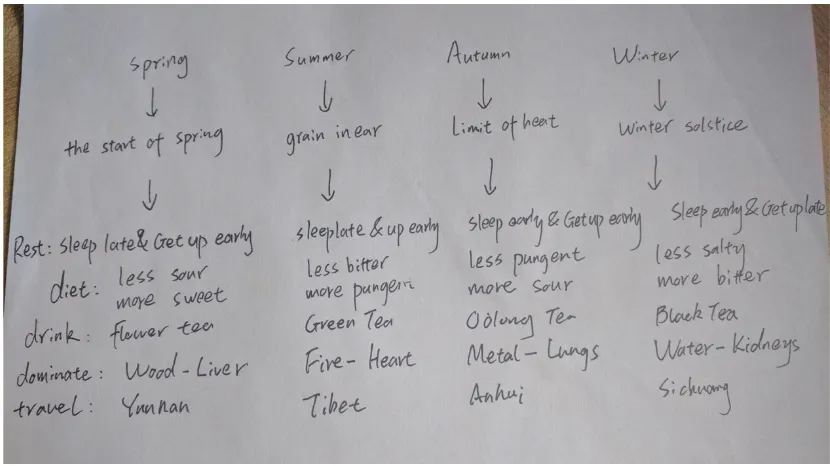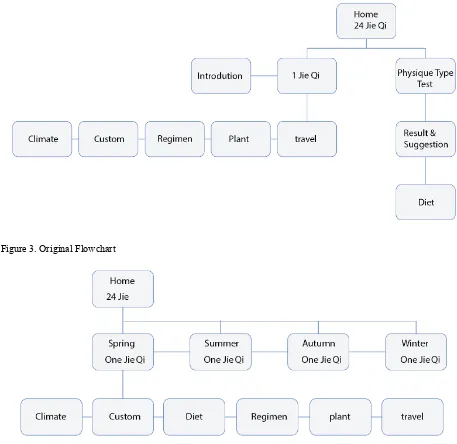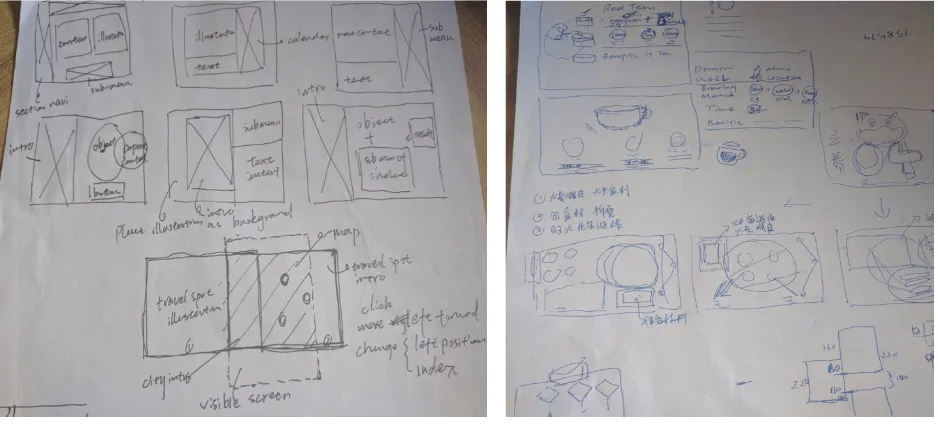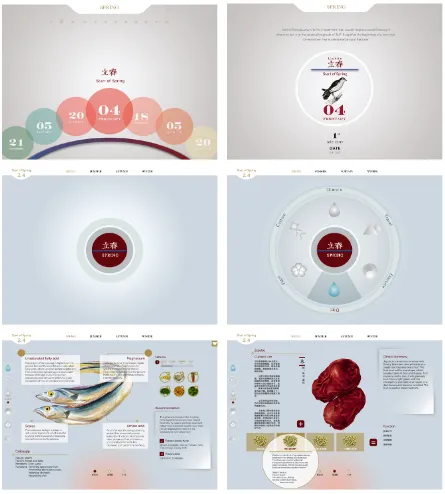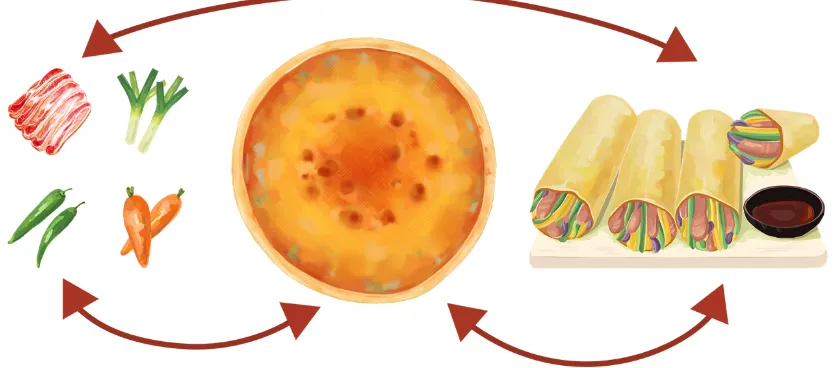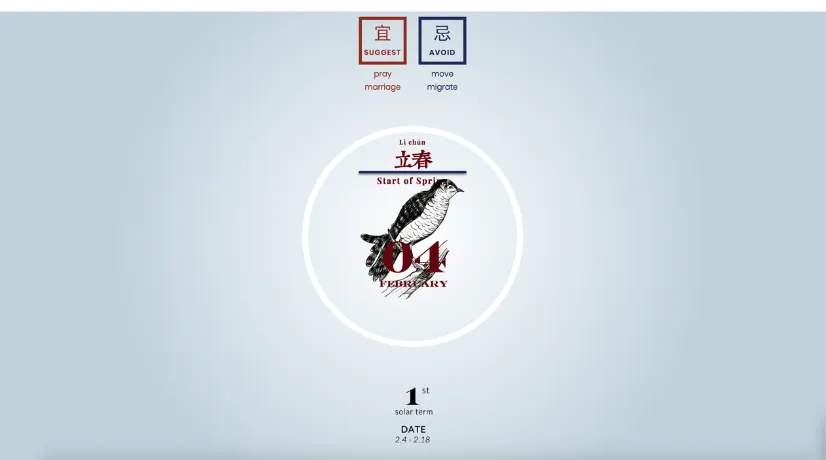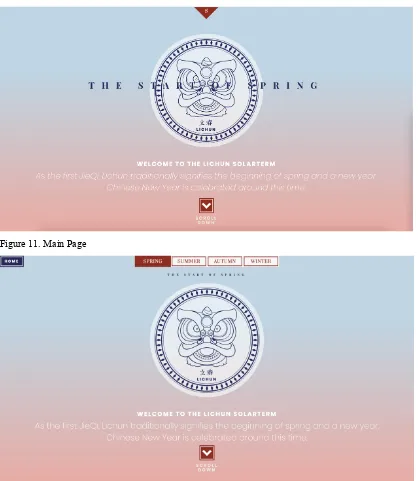Rochester Institute of Technology
RIT Scholar Works
Theses
8-1-2018
24 Jie Qi Journey: Learning Jie Qi Culture and
Living a Healthy Life
Yuqi Xiao yxx1578@rit.edu
Follow this and additional works at:https://scholarworks.rit.edu/theses
This Thesis is brought to you for free and open access by RIT Scholar Works. It has been accepted for inclusion in Theses by an authorized administrator of RIT Scholar Works. For more information, please contactritscholarworks@rit.edu.
Recommended Citation
24 Jie Qi Journey: Learning Jie Qi Culture
and Living a Healthy Life
By
Yuqi Xiao
Thesis Submitted in Partial Fulfillment of the Requirements for the Degree of Master of Fine Arts
in Visual Communication Design
School of Design College of Art and Design
Rochester Institute of Technology Rochester, NY
Title 24 Jie Qi Journey: Learning Jie Qi Culture and Living a Healthy Life Submitted by Yuqi Xiao
Thesis Committee Approval
Chief Adviser Marla Schweppe
Professor, Visual Communication Design
Signature Date
Associate Adviser Chris Jackson
Associate Dean, CIAS
Professor, Visual Communication Design
Signature Date
Associate Adviser Shaun Foster
Professor, Visual Communication Design
Table of Contents
1.0 Abstract 1 2.0 Introduction 2 2.1 Problem Statement
3.0 Research 3 3.1 Review of Literature
3.2 Target Audience
4.0 Process 5 4.1 Design Ideation
4.2 Content Structure 4.3 User Interface Design 4.4 Website Layout 4.5 Illustration
4.6 Website Development 4.7 Troubleshooting
5.0 Summary 21 5.1 Usability Testing
6.0 Conclusion 22 Appendix 23 A.1 Coding Examples of Web Design
Abstract
This project aims to explore new ways to spread traditional culture of Jie Qi and to teach a healthy lifestyle according the theory of Jie Qi. The project provides comprehensive design solutions through a website to remedy the problem of ineffective learning of complex knowledge from books and lack of communication. The website creates a virtual visual environment through interactive design that offer users a playful journey through an introduction of Jie Qi.
Jie Qi is a historic and significant invention. Based on observations of the sun’s movement integrated with natural phenomenon, starting about 3000 years ago, the ancient Chinese created a new time system called the lunar calendar that divides a year into 24 solar terms named Jie Qi to guide farmers in their agricultural plans (YU and Lao 2016). Each Jie Qi consists of 15 days and reflects obvious seasonal climate changes that provide a time frame to suggest diet rules,
regimen tips, and other aspects of a lifestyle based on the natural law of time. However, because the philosophy of Jie Qi involves a broad spectrum and comprehensive knowledge such as the religious culture of Taoist and traditional medicine theory, fewer and fewer young people in the modern era have even a basic concept of Jie Qi.
As the rapid development of IT technology updates the way we obtain information, more people prefer to accumulate knowledge through visual media than through text-based sources. The purpose of this website is to introduce Jie Qi to a younger generation and to anyone who is interested in Jie Qi cultures, as well as to teach people how to follow a healthy lifestyle associated with each season using Jie Qi theories. By understanding the philosophy of Jie Qi, people could see how nature helps people keep their body in optimal balance (Chen 2011). The project involved interactive design integrated with illustrations to represent a direct visual impression of Jie Qi in six areas: climate, custom, diet, regimen, plant and travel, making the information more concise and enhancing user experience. The goal of this project is to present the culture and connotations of Jie Qi in life, and to promote people’s deeper love for nature since Jie Qi builds a bridge between humans and nature.
Introduction
Problem Statement
Jie Qi, within the Representative List of the Intangible Cultural Heritage of Humanity, has being passed down for several generations as a way to regulate people’s daily lives. Through the core philosophy of Jie Qi, the wisdom of the ancients tells people how to adapt body status to the seasonal changes of the Earth, including what we should do to coordinate with nature-time (Zeng 2010). From a basic analysis of the heritage of Jiq Qi and by appreciating its significant
connotations, I tried to find the confluence of traditional knowledge and modern arts.
Biases toward and stereotypes about Jie Qi still remain in some peoples’ minds. From these perspectives, Jie Qi is an obsolete invention used for farming that is far from our daily lives. Furthermore, the cultures of Jie Qi are in danger of dying out today. Based on the research of the meanings and functions of Jie Qi, I found that Jie Qi involves many interesting areas. Jie Qi in modern society is not only useful for agriculture, but also affects the way we live. How to keep healthy is always a popular topic. By learning the principles of Jie Qi, people realize the
significance of the lifestyle as it complies with the natural laws of time, and therefore they want to know more about how to live in harmony with the earth and the best way to maintain health (Zhu 2013).
Research
Review of Literature Books
The Joy of UX
David Platt, Addison Wesley Professional, 2016.
This book guides developers to optimize user experiences for web and mobile through analyzing plenty of concrete examples. The author explains UX design principles, development techniques, and whole UX design process using real stories, and presents skills regarding interactive design. Developers can incorporate much useful advice from the book into the applications.
Creating Web Animation
Kirupa Chinnathambi, O’Reilly Media, 2017.
This is a strong foundation book for CSS and JavaScript web animation. The book teaches how to create excellent animations to solve problems through many code examples and a
comprehensive illumination of HTML, CSS, and JavaScript. Detailed technical skills of CSS animations and transitions are included in the book for designers to open the gate of web animation.
Book of Time
Yu Shicun and Lao Shu, China Friendship Publishing Company, 2016.
On the basis of researching a large number of traditional cultures and history, the author
discusses details of each Jie Qi. This book not only introduces the connection between Jie Qi and Chinese history, but also demonstrates how Jie Qi guides people’s daily lives and how Jie Qi plays an important role in the natural laws of time.
Diet and Regimen within 24 Solar Terms
Luo Mi, Jiangsu People Publishing Company, 2010.
Websites
Travel Japan within 24 Solar Terms Accessed September 10, 2014.
http://www.iseokagenosato.jp/kotonohagusa/
This website is travel guidance related to different Jie Qi, and introduces various local cultures related to Jie Qi. The layout design of the website is elegant and simple without any extra design elements.
The web technique animates whole pages using Adobe Flash to make seamless transitions. The nature photography included on this website depicts Japanese tourist resources and local customs.
Applications
Japanese 24 Solar Terms Heibonsha Limited, 2010.
This application publishes Ukiyoe style illustrations regarding local plants or foods on the beginning date of each Jie Qi. Through traditional painting and concise text introduction, users can gain a direct impression of Jie Qi. The application represents Jie Qi culture in the form of aesthetic expression.
Target Audience
Process
Design Ideation
The thesis research explored interaction, user interface design, and graphic solutions to present a visualized journey of Jie Qi through a website. Based on the website full of complicated
[image:9.612.71.490.412.655.2]information and large illustrations, the website was planned to be published only on a digital platform of tablets, desktop, and computer because mobile devices with small screens are not suitable for this project. The final outcome is a responsive website for large-screen devices. From the initial design strategy, the contents of the website include four selected typical Jie Qi, which have the mostly representative seasonal patterns in each of the seasons. These four selected characteristic Jie Qi include Start of Spring, Summer Solstice, Clear and Bright, and Winter Solstice; meanwhile, each Jie Qi demonstrates its contents in six areas: climate, custom activity, diet rules, regimen, seasonal plants, and travel spots. Due to the timeline of the project, I plan to complete the content for the Jie Qi of Spring (Start of Spring) (Li Chun 2013), and fill in the rest of the contents of the other seasons for the final implementation in the future.
The complex information architecture of the project generates plenty of pages. Page changing will often cause interruption through a second of white flash. Seamless transition can enhance the user experience by retaining the context, providing visual continuity, and maintaining user attention (Improving User Flow Through Page Transitions 2016). In order to avoid interruption and unstructured user flow, I designed all pages in a single page. All navigation pages are
organized in one page with a horizontal scroll for season changing and a vertical scroll for Jie Qi segments transition. Another reason for the one-page design is about storytelling. “24 Jie Qi Journey” is designed to provide a multimedia journey for interactive storytelling, and also story is the best medium for delivering information (Lupton 2017). Vertical long scrolling on one page takes the audience on a journey with all six sections of Jie Qi, and at the same time horizontal scrolling navigates users to different seasons. Like a site map, users will clearly distinguish their position on the entire page.
The goal of the project is to accomplish the promotion of Jie Qi culture. By presenting the relationship between Jie Qi and human life, Jie Qi inspires people’s enthusiasm for life and promotes their love for nature, thus guiding people to a healthy way of life following Jie Qi.
The major content focuses on two directions: 1. Jie Qi culture
Introduction of Jie Qi teaches the audience the basic knowledge of Jie Qi. Illustration integrated with interactive design conveys Jie Qi culture and related philosophy. 2. Healthy lifestyle from Jie Qi
Content Structure 1. Information collection
Based on a solid understanding of the project’s goal and its target audience, gathering and organizing information are the foundation of the design. First, the scope of the project needs to be confirmed. Jie Qi culture is involved in a wide scope of complex traditional knowledge, such as the religious culture of Taoist and Chinese medicine. To avoid the amount of information becoming overwhelming, the content only selects useful information relating to people’s life.
In Chinese medicine theory, one of the five elements dominates each of the seasons. Each element associated with a season tends to have an intense energy that manifests in the human body in that season (Promoting Health During the Four Seasons 2010). To maintain a balance of body energy, people should be careful about exercising and dieting practices that would further enhance the energy of the dominant element and break the balance. For example, Spring is dominated by the wood element, which refers to the organ the liver. People should minimize the intake of sour foods, as they promote the energy of the wood element (liver), and meanwhile increase sweet foods since they promote the energy of the earth element (spleen). The earth element is suppressed by the wood element, so obeying this dietary rule will adjust the energy in the body to maintain a healthy balance. According to the interconnected philosophy and
[image:11.612.71.486.464.697.2]medicine theory, I gathered the keywords from each season that relate to our lives (Figure 2).
2. Information flowchart
[image:12.612.72.529.222.666.2]An information flowchart was created to present the structure and the planning of the project. In the original plan (Figure 3), I designed a body physique type test for users to navigate for diet recommendations. Due to the limitation of database techniques, the physique type test function was removed. In the final design (Figure 4), except for the individual page of the home page for 24 Jie Qi, all other pages are connected and designed in one page for ease of content comparison between seasons without the interruption of page refreshing.
Figure 3. Original Flowchart
User Interface Design 1. Wireframe
Wireframes help me to keep the design consistent throughout all the site’s pages, and also arrange the content and functionality in the pages. During the wireframe process, I changed many methods to simplify the path of page transition, and removed unnecessary elements.
[image:13.612.73.542.176.388.2]
Figure 5. Wireframe 1 Figure 6. Wireframe 2
2. Color Palette
Proper use of color will have positive influences on the feeling of the whole site. To highlight main subjects and coordinate with the watercolor illustrations, I chose low saturation colors for the background for every section. The colors in low saturation with a little gray tone bring transparency and make more colors appear uniform in the limited area, allowing audiences to relax and focus on the information (Krug 2014).
Color is an important element to convey a specific sense and emotion to viewers. Because the website topic is about traditional Chinese culture, I selected the most representative colors of China as the web color palette: red, blue, and gold.
• Red, which symbolizes good fortune in Chinese culture, used to be the main color for text
• Dark blue, which is associated with calmness and stability, is widely used on pure porcelain
in ancient China. I used blue for the text background and navigation bar since it would not distract user’s attention from the content.
• Gold denotes a sense of luxury and is a symbol of royalty; therefore, it is used as decoration
to match with red and blue on the web interface.
3. Original Interface
There are four Jie Qi assigned to each of the seasons; therefore, scrolling transitions was designed for these seasons that are similar to the pages-turning effect. Each season’s page focuses on one representative Jie Qi with its unique background color, which symbolizes the features of that season. As Jie Qi is a nature-time system, I created a timeline carousel as a metaphor for the gear of time, which allows users to select which Jie Qi they are interested in. The whole website is designed as an interactive calendar, which is convenient for users to connect time with other information.
[image:15.612.71.516.71.565.2]
Figure 7. First Version Interfaces
sub-menu, which navigates users to subset content. To solve this problem, I added pause points for each section that allows users to stop at the current section. Website background color changes correlate with the current section a user is browsing.
4. Animation
At the beginning, I built a sequence animation, which ran throughout the whole page and was playing by scrolling down. The long scrolling page features illustrated tourist routes that various invisible animations about Jie Qi become visible onto the screen in sequence. But an animation error occurred when I added pause points on the vertical scrolling. Due to the conflict of functions, I removed the disordered animation and built animations with move-in effect while crossing each section. When users move in each section through scrolling, animation from that section will fade-in to auto play and fade-out when move to the next section.
[image:16.612.90.509.497.681.2]Time control of animation is a complicated design process. To avoid movement conflict, logically arranging animation time and duration is very important. For instance, a cooking process of a pancake to introduce Jie Qi festival customs was animated. There are three steps of the process built in the form of animation. I needed to make some assumptions about users’ actions. If the user’s click action is from step 1 directly to step 3, step 2 as the middle transition will be missing. Therefore, animations between any two of three steps according to a user’s possible click sequence should to be designed properly (Figure 8).
Programing and debugging is another challenge for the website. I created all animations using CSS, SVG, JavaScript, and JQuery.
5. Typeface
To make sure the font matches the web topic and content, choosing an appreciate typeface was crucial. Because of the large illustrations, a light font such as a slim rounded typeface was a good choice to reduce the content crowding. For keeping consistency in the visual style, the
personalities of typeface were defined as classic, friendly, and elegant. Finally, I selected two free Google fonts that are easy to embed on the web and excellent for the web style.
Playfair Display
This is a classic serif font. The high contrast and curves make the typeface looks elegant, especially the italic. I used this font primarily for titles and headlines, and moreover the font with many weight choices creates a harmonious hierarchy. When combined with a light background color it evoked a sense of reliability.
Poppins
Website Layout 1. Home page
[image:18.612.70.490.215.693.2]The homepage (Figure 9) contains two navigations to 24 Jie Qi. Beside the carousel of Jie Qi circles at the bottom in a scroll, a timeline of Jie Qi in buttons coordinates with the carousel, taking a look at the date of each Jie Qi. When users picked one Jie Qi they might be interested in, the lunar calendar about this Jie Qi will fade in on the center screen, which shows the suggested activity and avoided activity during this Jie Qi (Figure 10).
[image:18.612.73.486.462.692.2]Figure 9.Homepage
2. Main page
[image:19.612.73.491.211.692.2]After a short animated introduction of the selected Jie Qi, the homepage (Figure 10) transitions to the main page of Jie Qi in Spring (Figure 11), which contains six sections of content regarding this Jie Qi. The main page starts with a section where users scroll down to load the interactive animation. When the scrolling reaches the bottom, the start section jumps to the first section of Jie Qi with seamless transitions. The top red “S” represents seasons; clicking it reveals the navigation bar where users can transfer to another season (Figure 12).
Figure 11. Main Page
2-1. Climate Section
This section is the first one to introduce Jie Qi climatic features, natural phenomenon and related knowledge. Each Jie Qi is divided into three pentads equaling five days each, and every pentad has its unique climatic features. The pentad buttons are designed in the form of cards users can pick (Figure 13). When users select one card, the illustration of the natural phenomenon about this pentad’s features will be gradually show on the screen, showcasing the natural symbols of climatic change (Figure 14). The illustration combined with the calendar date on the right reminds users of the specific time area of the pentad within this Jie Qi.
[image:20.612.70.518.238.358.2]
Figure 13. Climate Section 1 Figure 14. Climate Section 2
2-2. Custom Section
This section presents Jie Qi customs and festival activity through an interactive design conveying aspects of culture. Using the playful design offers a more enjoyable user experience of learning about Jie Qi than reading a long text. Some pieces of short animation demonstrating how to make festival food such as pancakes make the user experience user-friendly. The top right square buttons control the animation in three steps, and the text in the left square changes content
corresponding to the steps of the animation.
[image:20.612.67.515.543.659.2]
2-3. Diet Section
The diet section explores diet rules and habits to demonstrate the principle of a health regimen from Jie Qi. The diet suggestions are from three areas: food, herbs, and tea. Users learn how to adjust their dietary habits from the comprehensive introduction of beneficial diet suggestions.
Figure 17. Food Slider 1 Figure 18. Food Slider 2
Figure 19. Herbs Slider
[image:21.612.71.520.131.688.2]
2-4. Regimen Section
[image:22.612.72.491.175.400.2]This section exhibits a guideline of acupressure points on the body, teaching users how to do the acupressure massage (feisong and zhao 2014). The model with red points reveals a circular box for explaining the position and function of each acupressure point. A small model with hotspots controls the display area of the large model. The hotspots contain two areas: body and foot.
Figure 22. Regimen Section
2-5. Plant Section
This section introduces the seasonal plants from four aspects: place, habit, usage, and sayings.
[image:22.612.74.486.480.704.2]2-6. Travel Section
[image:23.612.73.490.191.672.2]The travel section suggests the best travel destinations during the current Jie Qi. A brief introduction of three travel spots offers users the choice of which travel route they might be interested in. For the design of the showcase, I built two layers (Figure 24, Figure 25) that partly overlap, with revealed part showing the selected content. By changing the index of layers and absolute position of the left, the showcase displays different content.
Figure 24. Travel Section - Top Layer
Illustration
After collecting all of the informational content of the project, organizing the visual content and defining the visual style were in progress. Based on the feature of a long history of Jie Qi, the visual elements define traditional Chinese style. Chinese ink and wash painting is very
representative of the Chinese style. Watercolor has similar characteristic features as Chinese ink and wash painting such as light transparency, which invokes a sense of mystery and the ethereal. To remain maximum details of hand drawing, I used Coral Painter to create all artworks.
[image:24.612.73.489.218.375.2]
Figure 26. Calendar Illustration 1 Figure 27. Calendar Illustration 2
Website Development
The website development mainly used HTML5, CSS3, SVG, JavaScript and JQuery. 1. Responsive Layout
On completion of visual design, I got started on website programing. The project’s target platform is a large mobile device or desktop. For the responsive layout, multiple breakpoints were set in CSS for four groups of screen resolution: larger than 768px for tablets, larger than 992px for medium devices, larger than 1380px, and larger than 1681px for large devices. 2. One Page Web
Troubleshooting
[image:25.612.72.487.219.375.2]Some technical problems occurred during the website performance. Fortunately, most problems were successfully solved. In the diet section, sliding from the first slider to the third slider always resulted in afterimages since it jumped the middle one and there was a shortage of response time. I assumed that if it was always setting the next slider in the adjacent position to the current one, the response time would be minimized. Then I analyzed the sliders’ position (Figure 28) and wrote code in JavaScript to arrange it so the next slider always adjoined the current slider.
Figure 28. Sliders Transition Analyses
Summary
Usability Testing
I invited my professors and friends to test the website and observed their actions while they were browsing. Based on the result of those observations and feedback, I summarized the site’s problems and solutions as follows:
• No obvious button to go back to the start page
Modification: Change the back button with hover status to fixed visible button
• Start page only has scroll function without click function
Modification: Apply click function on button
• Overloaded hierarchy of fonts
Modification: Simplify font hierarchy, uniform font size and weight
• Visual overlap with some objects
Conclusion
An outstanding website is more than just a combination of interactive and visual elements. Through accomplishing this project, I learned that provide a great experience to users it is essential that design, content, and interaction are consistent (Colborne 2010). For a convenient user experience, designer should understand the user’s perspective, and represent the goal through multiple process including research, content organization, design consistency, and function implementation.
“Jie Qi Journey” takes audiences on a virtual journey through Jie Qi history and explores Chinese culture, which is not only intended to share Jie Qi culture, but also as guidance for a healthy lifestyle. The project improves the efficiency of absorbing information through the website, and helped people who have difficulty reading or understanding long text. Furthermore, the project aimed to draw people’s attention to the relationship between nature and man.
Traditional culture incorporated with interactive web design attracts more audiences to visit it.
Based on the user feedback and various considerations, some extra elements from the initial design were removed from the interface and content structure, and it was finally changed to a concise and content-rich website. Due to the time schedule and technical constrains, the project still has a lot of room for potential improvements in future implications, including:
1. Polish the uniformity of web interface and interaction 2. Complete the rest of the seasons (beyond Spring)
3. Expand digital platform to other kinds of media, such as mobile app or VR app 4. Develop more playful features
Appendix
Code Examples
In the front-end development, I used Css3, Html5, SVG, JQuery, and JavaScript to build a whole website. In order to make the code better organized and reduce repetition, the code was revised many times. The clean code is more convenient to read and easier to maintain in the future.
[image:27.612.74.533.238.671.2]HTML5
CSS3
Figure 30. CSS Screenshot 1
[image:28.612.73.246.452.659.2]SVG
Figure 32. Svg Screenshot 1
[image:29.612.71.544.487.682.2]JQUERY
Figure 34. JQuery Screenshot 1
[image:30.612.72.544.464.669.2]JAVASCRIPT
Bibliography
Colborne, Giles. Simple and Usable: Web, Mobile, and Interaction Design. New Riders, 2010.
Lupton, Ellen. Design Is Storytelling. Cooper Hewitt, Smithsonian Design Museum, 2017. Krug, Steve. Don’t Make Me Think. New Riders, 2014.
Yu, Shicun, and Shu Lao. Book of Time. China Friendship Publishing Company, 2016. Zeng, Zimo. Huangdi Neijing 24 Jie Qi Yang Sheng Fa. China Agriculture Press, 2010. Zhu, Wei. Wei Du Jie Qi. China Federation of Industry and Commerce Press, 2013.
Chen, Feisong, and Peng Zhao. Jing Luo Xue Wei An Mo Su Cha Quan Shu. Jiangsu Science and
Technology Press, 2014.
Chen, Richard C. “The Meaning of Qi.” FENG SHUI. June 24, 2011. Accessed August 2, 2015. http://fengshuicilacap.blogspot.com/2011/06/qi-3.html.
“Li Chun.” Life Week Magazine. February 1, 2013. Accessed July 4, 2015. http://www.lifeweek.com.cn/2013/0201/39904.shtml.
“Promoting Health During the Four Seasons.” The Lessons of Shennong. October 2010. Accessed July 21, 2015. http://www.itmonline.org/articles/four_seasons/four_seasons.htm. “Improving User Flow Through Page Transitions.” Smashing Magzine. July 05, 2016. Accessed May 8, 2017. https://www.smashingmagazine.com/2016/07/improving-user-flow-through-page-transitions/.
Duckett, Jon. JavaScript and jQuery: Interactive Front-End Web Development. John Wiley & Sons, 2014.
